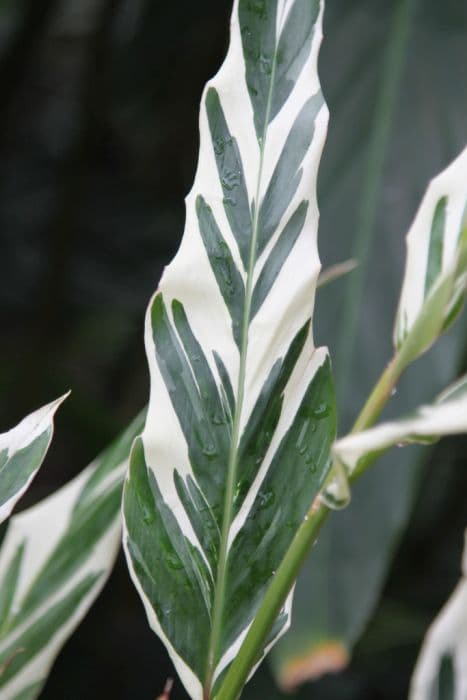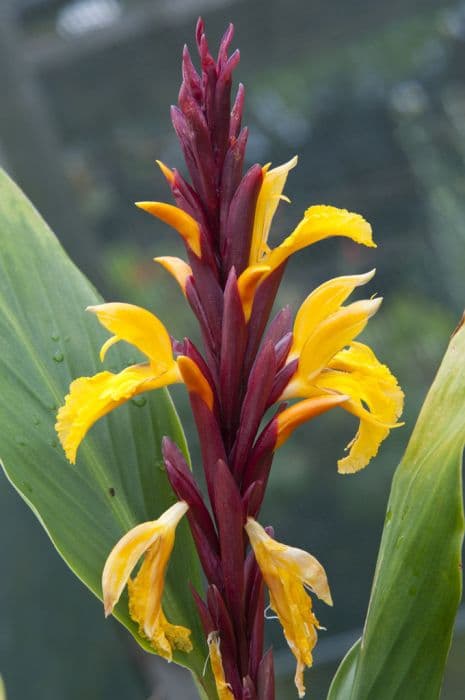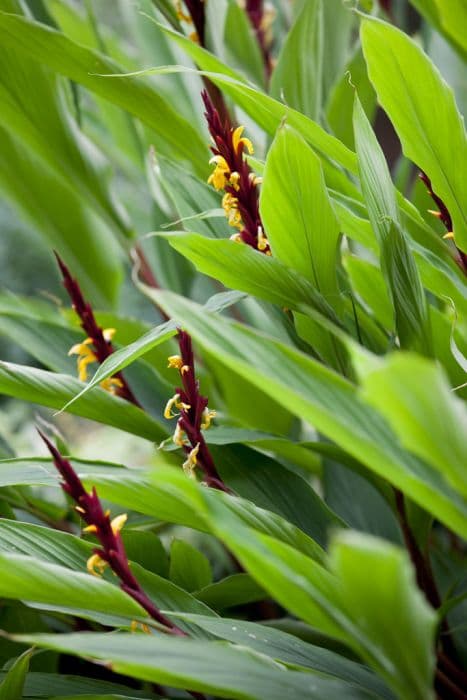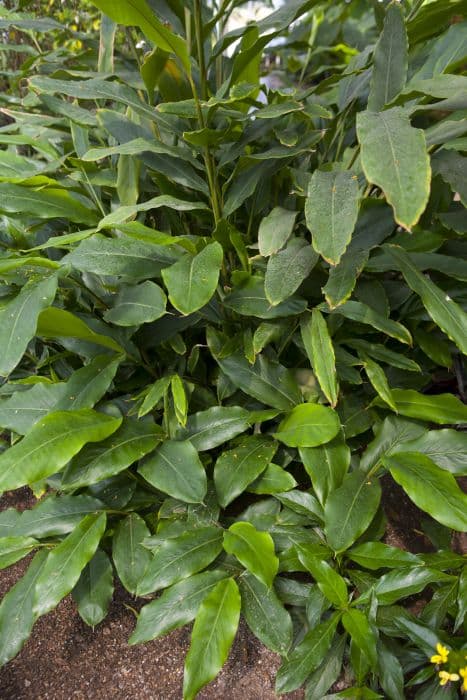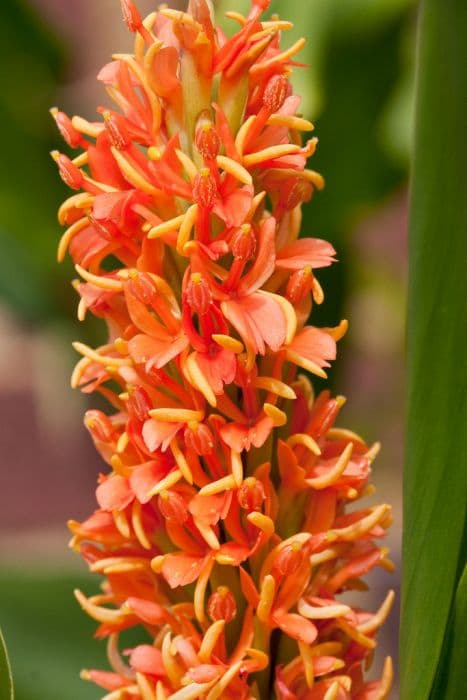Cautleya Spicata Roscoea cautleyoides 'Abigail Bloom'

ABOUT
The plant known as 'Abigail Bloom' is a visually striking perennial that displays a variety of appealing features in a garden setting. It boasts a lush foliage that is deep green in color, providing a rich backdrop for the plant's more prominent attraction, its unique flowers. These flowers are a distinctive feature, characterized by their attractive, orchid-like shape. They exhibit a pale to deep yellow hue which often carries a gradient of color that deepens toward the flower's center or edges, giving each bloom a bespoke appearance. The leaves of 'Abigail Bloom' are elongated and slender, with a smooth texture that feels pleasant to the touch. They form a clumping base from which the bloom stems emerge. The flowers are borne atop these stems, which gracefully rise above the foliage, presenting the blooms in a way that seems to invite admiration. Further contributing to the plant's charm are the subtle streaks or spots of a contrasting color that can sometimes adorn the petals, adding depth and complexity to the flower's presentation. When in full bloom, this plant presents a delightful display that can catch the eye and become a focal point in a garden's visual composition. It's worth noting that the blossoms might also come with a sweet fragrance, adding an olfactory dimension to its aesthetic appeal. Overall, 'Abigail Bloom' exudes a tropical allure, despite being able to thrive in less exotic environments. It's a testament to the allure of this plant that it can add such vibrancy and beauty to a space without the need for grander dimensions, proving that sometimes the most enchanting garden treasures come in modest packages.
About this plant
 Names
NamesFamily
Zingiberaceae.
Synonyms
Cautleyoides Ginger, Abigail Bloom Ginger Lily.
Common names
Roscoea cautleyoides 'Abigail Bloom'.
 Toxicity
ToxicityTo humans
Roscoea cautleyoides 'Abigail Bloom', commonly known as Roscoea, is not known to be toxic to humans. There is no typical symptom of poisoning as this plant is generally considered non-toxic.
To pets
Roscoea is not known to be toxic to pets either. As it is generally considered non-toxic to animals, there are no expected symptoms of poisoning from ingesting any part of this plant.
 Characteristics
CharacteristicsLife cycle
Perennials
Foliage type
Deciduous
Color of leaves
Green
Flower color
Purple
Height
1-2 feet (30-60 cm)
Spread
0.5-1 foot (15-30 cm)
Plant type
Herb
Hardiness zones
6
Native area
Himalayas
Benefits
 General Benefits
General Benefits- Ornamental Value: Provides aesthetic appeal with its attractive flowers and foliage.
- Low Maintenance: Requires minimal care once established, making it suitable for gardeners of all skill levels.
- Drought Tolerance: Once established, it can tolerate periods of low water availability.
- Cold Hardy: Can withstand cooler temperatures, thus suitable for a range of climates.
- Attracts Pollinators: Flowers attract bees and butterflies, promoting biodiversity.
- Compact Growth: Suitable for small gardens or containers where space is limited.
- Long Blooming Period: Offers a lengthy display of flowers during the blooming season.
- Versatility: Can be used in various garden designs, including borders, woodland settings, and rock gardens.
- Deer Resistant: Less likely to be eaten by deer, which is beneficial in areas where deer are a problem.
 Medical Properties
Medical PropertiesThis plant is not used for medical purposes.
 Air-purifying Qualities
Air-purifying QualitiesThis plant is not specifically known for air purifying qualities.
 Other Uses
Other Uses```html
- Photography Subjects: Gardeners often grow Roscoea cautleyoides 'Abigail Bloom' for its unique and photogenic flowers, capturing them in various stages of bloom for plant photography portfolios.
- Artistic Inspiration: The striking appearance of the 'Abigail Bloom' can inspire botanical illustrations and paintings, serving as a subject that provides artists with rich colors and interesting forms.
- Educational Tool: This plant can be used by educators to teach botany, particularly about the Ginger family (Zingiberaceae), demonstrating plant anatomy and pollination.
- Theme Gardens: 'Abigail Bloom' is suitable for Asian-themed gardens, providing an authentic representation of its native himalayan habitat aesthetics.
- Culinary Decor: Although not commonly consumed, the vibrant flowers can be used as non-toxic garnishes for high-end culinary presentations.
- Perfumery: While not a regular practice, the subtle fragrance of its flowers could potentially be captured by specialty perfumers for exquisite, bespoke fragrances.
- Craft Projects: The flowers and leaves of 'Abigail Bloom' can be pressed and dried for use in crafting, such as homemade greeting cards or bookmarks.
- Flower Arranging: Fresh or dried, these flowers may be included in floral arrangements, particularly for events that desire an exotic, oriental look.
- Container Gardening: Its compact size allows for it to be used as a potted plant, adding a touch of the exotic to balconies, patios, or indoor spaces.
- Seasonal Celebrations: In areas where it blooms, 'Abigail Bloom' can be included in festivities or religious ceremonies that call for fresh flowers, especially in spring and summer months.
Interesting Facts
 Feng Shui
Feng ShuiThe plant Roscoea is not used in Feng Shui practice.
 Zodiac Sign Compitability
Zodiac Sign CompitabilityThe plant Roscoea is not used in astrology practice.
 Plant Symbolism
Plant Symbolism- Exotic Allure: Roscoea cautleyoides 'Abigail Bloom', commonly known as "Roscoea," often symbolizes exotic allure due to its origins from the Himalayan regions, presenting a fascinating appeal with its unique floral structure.
- Elegance: The elegant and delicate form of Roscoea flowers can represent grace and sophistication.
- Survival: Roscoeas are known for their hardiness in cool climates, despite their tropical appearance, thus they can symbolize strength and the ability to thrive under adverse conditions.
- Rarity: As Roscoea cautleyoides 'Abigail Bloom' is not a very common garden plant, it can be associated with rarity and the value of uncommon beauty.
- Adaptability: The plant's ability to adapt to various climates suggests a symbolism of flexibility and versatility in life.
 Water
WaterThe Cautleya spicata, commonly known as Hardy Ginger, prefers consistently moist soil, especially during the growing season. Water the plant once or twice a week, ensuring the soil is damp but not waterlogged. On average, this equates to about 1 gallon of water per week, depending on environmental conditions such as heat and humidity. During hot spells, you may need to water more frequently. In winter, when the plant is dormant, reduce watering significantly, only to prevent the soil from completely drying out.
 Light
LightHardy Ginger thrives under partial shade conditions. The ideal spot for this plant is in dappled sunlight, such as under the canopy of larger plants or trees. Direct afternoon sun should be avoided, as it can cause the leaves to scorch. East or north-facing gardens are often ideal settings for these plants.
 Temperature
TemperatureHardy Ginger prefers temperate climates and can generally withstand temperatures down to about 15 degrees Fahrenheit during dormancy. The ideal growing temperatures are between 60 and 75 degrees Fahrenheit. It is important to protect the plant from frost and extreme cold, which can damage or kill it.
 Pruning
PruningPruning Hardy Ginger is done primarily to remove spent flowers and dead or damaged foliage, enhancing its appearance and encouraging healthy growth. The best time to prune is in the late fall or just before new growth begins in spring. Typically, pruning is needed once a year, but you can remove dead leaves or flowers as they appear throughout the growing season.
 Cleaning
CleaningAs needed
 Soil
SoilFor the Himalayan ginger 'Abigail Bloom', a well-draining soil mix with a pH of 6.5 to 7.5 is ideal. Incorporate loam, sand, and well-rotted organic matter to provide a rich, fertile foundation, reminiscent of its natural woodland habitat.
 Repotting
RepottingHimalayan ginger 'Abigail Bloom' typically requires repotting every 2-3 years. When the plant becomes root-bound or the soil appears exhausted, it's time to repot into a slightly larger container to ensure continued health.
 Humidity & Misting
Humidity & MistingThe Himalayan ginger 'Abigail Bloom' prefers moderate humidity levels, benefiting from an environment with around 40-60% humidity which mimics its native mountain woodland conditions.
 Suitable locations
Suitable locationsIndoor
Place in bright, indirect light with consistent moisture.
Outdoor
Position in dappled shade, shielded from harsh sunlight.
Hardiness zone
6-9 USDA
 Life cycle
Life cycleRoscoea cautleyoides 'Abigail Bloom', commonly known as Kew Beauty, begins its life cycle as a rhizome, which sprouts in late spring, emerging later than most perennial plants. The sprouting stage involves the unfurling of lance-shaped leaves, followed by a flowering stage in summer when it produces its distinctive purple or lavender blooms which resemble orchids. After pollination, typically by insects, the flowers develop into seed capsules. Once the seeds mature, they are dispersed, completing the reproductive stage. During the autumn, the aerial parts of the plant die back as it enters dormancy, conserving energy within the rhizome for the next growing season. With the return of favorable conditions in spring, the life cycle recommences with the emergence of new growth from the rhizome.
 Propogation
PropogationPropogation time
Spring-early summer
The most popular method of propagation for Roscoea cautleyoides 'Abigail Bloom', more commonly known as hardy ginger, is by division. This process is best carried out in the spring as the plant emerges from dormancy. Firstly, carefully dig up the plant, ensuring to get as much of the root system as possible. You will notice that the rhizomes, which resemble tuberous roots, have multiple growth points. Using a clean and sharp knife, divide the rhizome into sections, making sure each section has at least one growth point. The sections can then be replanted into the ground or pots filled with a mix of compost and garden soil, spaced about 8 to 12 inches (20 to 30 centimeters) apart, and watered thoroughly. This division helps to rejuvenate the plant and also proliferates your collection of hardy ginger.
